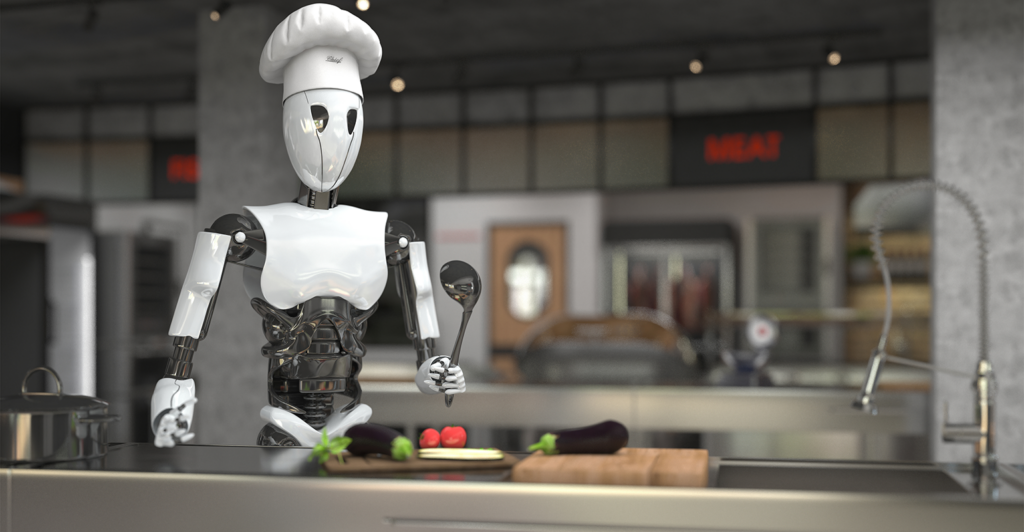AI can drive restaurant industry revenue and profits — if you can look past the hype
Here are 8 ways that AI can alleviate restaurant problems.
11 June 2024
Share this exclusive content from Saladplate

Even with gen AI’s current growing pains, it’s not going away. | Photo Credit: Julia Garan/Getty Images
Restaurants should be celebrating the continued tech innovation that creates new efficiency opportunities in their kitchens. But the industry’s old and new challenges threaten to outrun some of that opportunity.
Technologists tend to offer “more tech” as the blanket solution restaurateurs need. As the rise of generative artificial intelligence embeds itself in practically every industry and institution, owners and operators are naturally skeptical. ChatGPT’s aptitudes don’t extend to dishwashing or preparing omelets (yet).
Yes, there is a lot of hype around what gen AI can do. But there are practical roles for this rapidly advancing tech in easing many of the difficulties restaurants are dealing with right now.
Even with gen AI’s current growing pains, it’s not going away. And neither are restaurants’ mounting headaches: inflationary pressures remain relentless in squeezing operators and consumers alike; the supply chain, labor, and arguably tighter-than-ever profit margin strains are keeping food service executives up at night.
AI is not an experiment — it’s now
Restaurateurs, as much as anyone — and maybe more than most — have senses that are particularly fine-tuned to big promises from tech. Many view the latest software and tolls as costly distractions from the daily goal of pleasing the guests that drive revenue and profits.
Tech is simply a way of life for everyone. Restaurants can’t ignore that. Jumping on the AI bandwagon is not a strategy, of course. It’s also not about experimenting for what might become the norm in the near future, though there is value in such preparation.
The truth is, even in this relative early moment in the AI Era, many restaurant brands are getting in on the AI action. And they’re quickly finding ways to make it work in practical terms.
Chain restaurants move forward
Some are dipping toes into the AI water, like White Castle, Checkers/Rally’s, and many in between. These chains have been testing or rolling AI voice ordering through the phone or drive-thru, with more and more success.
Many are watching everybody else wade into the pool and going in only if the water seems warm enough. A small handful of others are doing cannonballs off the deep end.
Domino’s is always a leader in interactive customer service. And that continues to be the case. Back in 2018, Domino’s declared its “quest for digital dominance” in the restaurant industry by expanding its investment in developing platforms by launching a voice recognition application to take telephone orders coming into its stores.
By the fall of 2023, Domino’s began partnering with Microsoft to take its AI ambitions even further. Beyond taking on the task of processing mobile ordering, Domino’s experiments with AI have been focusing more broadly on modernizing store operations. The company said that it is in the early stages of developing a generative AI assistant with Azure to help store managers with inventory management, ingredient ordering, and scheduling.
In April, Yum Brands took an admirable position on the deep end of the pool with investment in becoming an “AI-first” company, looking at solutions across the board, from back-of-house to guest-facing.
Yum Brands’ vision for “AI-powered” fast-food is intended to shape practically every facet of how its Taco Bell, Pizza Hut, KFC, and Habit Burger Grill restaurants are operated. Joe Park, Yum’s new chief digital and technology officer, told the WSJ this spring that the fast-food holding company has been increasing its 2023 tech and automation investments. About 45%, or about $30 billion, of Louisville, Ky.-based Yum’s sales are digital, Park said, roughly double the level in 2019.
What AI is capable of
Importantly, AI isn’t just for the major brands. Just as every restaurant faces the same pressures we mentioned earlier, here’s how AI can help alleviate and even turn problems into growth opportunities:
Labor Costs: With rising minimum wages and competitive job markets, labor costs are increasing. Efficient labor management is essential to improve profit margins. AI can now easily enhance this efficiency.
Employee Retention: In a competitive market and hyper-competitive industry, employee loyalty is a bigger challenge than ever. AI can improve job satisfaction and operational efficiency, giving employees fewer reasons to leave.
Food Costs: Although there’s been some relief, supply chain issues persist. AI can optimize inventory management and reduce waste, providing a competitive edge.
Guest Experience: As customer expectations for value rise, AI can enhance the dining experience by predicting customer behaviors and personalizing service. Finally, the promise of 1:1 marketing may actually be here.
Product Consistency: High staff turnover can lead to inconsistencies in food quality. AI can forecast busy periods and even automate some kitchen processes to maintain or enhance consistency and quality.
Pricing: With rising costs and inflation, setting the right menu prices is crucial. AI supports more data-rich and dynamic pricing strategies that can adapt without alienating customers.
P&L Optimization: With tighter margins, AI can quickly and thoroughly analyze profit and loss statements to identify insights and efficiency opportunities, enhancing both profitability and operational speed.
Innovation: Predicting trends has always been challenging. AI simplifies this by analyzing data and becoming an anticipator of food and cultural trends, aiding in product development and marketing.
Companies that smartly take aggressive but thoughtful positions like Yum Brands will find the payoff in customer loyalty and the important area now of team member loyalty.
Reality and magic
Still, AI is not magic. There’s no “set it and forget” function.
With success in the restaurant industry measured according to sales, customer traffic, and profitability, the ROI from AI initiatives demands close attention — especially since these investments can vary in scale.
Beyond these fundamental metrics, it’s crucial to monitor consumer sentiment through brand loyalty and technology effectiveness indicators. Experience satisfaction metrics, such as net sentiment and net promoter scores, are also essential, as they evaluate whether a guest’s experience justifies their expenditure in their mind.
Equally important is team member satisfaction. That’s the best measurement for judging any change in operations. AI investments should lead to enhanced employee satisfaction and retention, pure and simple. Subsequently reducing the costs associated with training new staff is another box to check on assessing AI implementation. Ultimately, AI should free operators up so more effort can be placed on satisfying the guest.
The myriad opportunities for AI to positively impact various aspects of the business mean now is the time for restaurant leaders to act.
By running toward and embracing AI — sensibly, thoughtfully — rather than sitting still and questioning it, we can more aggressively enhance the restaurant industry and secure its future success for restaurant teams and their patrons.

Source: Nation’s Restaurant News



